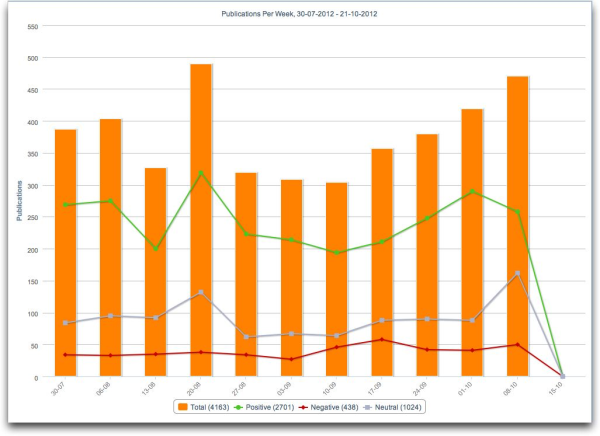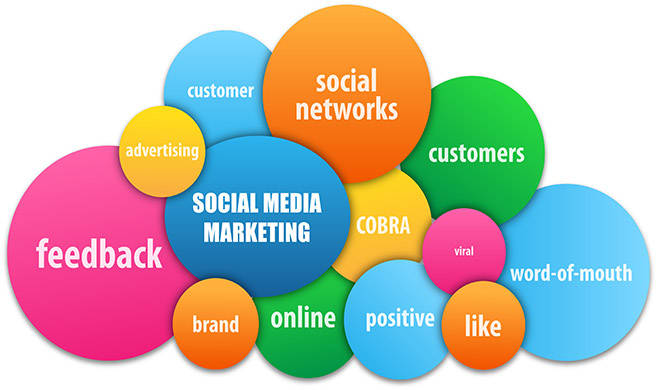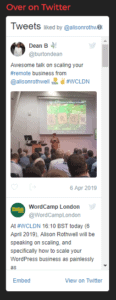Word of mouth is one of the oldest (and most effective) forms of marketing. But, does it translate into the online world?
Ultimately customers trust the opinions of other customers more than what brands have to say.
So, it’s your job to ensure you’re encouraging and leveraging word of mouth marketing to build brand awareness and trust with potential customers.
Luckily, the rise of electronic word of mouth means reaching new audiences at scale is easier and more effective than ever before.
Keep reading to discover what electronic word of mouth marketing is, how it differs from traditional word of mouth marketing and a stack of practical ways you can leverage this in your existing marketing toolkit.
What is electronic word of mouth?
How do you decide which product or brand to buy? No matter what we’re shopping for, you want to make sure we’re picking the best option on the market.
So, you do your research. You might jump onto Google, read a few customer reviews and even browse through the brand’s social channels.
Why? Because you want to know what other people think about this product or brand, and whether they’d recommend it or not.
And that is exactly what electronic word of mouth (EWOM) is all about. It’s a way of scoping out previous customer’s opinions online and seeing what they think about a product or service we want to buy.
Instead of relying solely on a brand’s website or marketing materials (that will only tell one side of the story), electronic word of mouth gives us a more honest, candid perspective. It covers everything from reviews to testimonials and even social media posts and provides an unfiltered version of how other customers feel about this brand.
The goal of EWOM is simple: for consumers to help other consumers make an informed purchase decision.
And here’s why it matters: 88% of people trust online reviews from other consumers just as much as they trust recommendations from their family and friends.
The more we trust a brand, the more likely we are to shop from them. And for businesses and marketers, leveraging EWOM can set your business apart (without the need to spend thousands of dollars on advertising).
With just 33% of businesses actively seeking out and collecting reviews, there’s a huge opportunity for your brand to proactively encourage and leverage these value pieces of social proof to impact your bottom line.
What are the core components of electronic word of mouth?
There are three key components that make up EWOM which work together to influence brand perceptions and ultimately drive conversions.
These key components are:
- The message
- The channel
- The receiver
Let’s break each part down.
The Message
This component of EWOM is all about the specific piece of content created by your customers. In most cases, it will be a rating, review or testimonial that reveals how they feel about your product, service or overall brand experience.
Unlike the rest of your marketing toolkit, you have no final say over what message is distributed to the world through EWOM.
Instead, your customers have the ability to speak freely about their experience (positive praise or negative reviews) with your brand. While this can be a helpful tool to build trust with new customers, it can be a double edged sword (but more on that in a minute).
The Channel
Next up, we have the tools your customers use to share their message with the world. In the case of EWOM, the channels available to your audience typically include:
- Reviews on your website (such as leaving a review on your eCommerce store)
- Third-party review platforms (such as Trustpilot or ProductReview.com,.au)
- Online forums or communities (such as Facebook Groups)
- Social media platforms
Each tool offers different ways for users to share their experience with your brand. Some might use a star rating system while others might offer open-ended questions and text boxes.
The Receiver
Finally, we have the person on the other end of the review: the receiver.
This will typically be potential customers that are researching your brand and looking for an honest perspective on your products or services.
Their goal is to understand the general sentiment towards your business:
- Do other people like and trust this brand?
- What is the true quality of their product and services?
- Are there better options to choose instead?
These three components of EWOM are what make this type of marketing so effective. EWOM gives potential buyers the opportunity to hear from hundreds of past customers and learn whether this product or brand is really worth their money.
By offering opportunities for your customers to share positive experiences with your brand online, you’ll be able to boost your appeal to potential buyers (without having to invest in traditional advertising).
What are the stages of electronic word of mouth?
But it doesn’t stop there. When it comes to EWOM, there are three key stages you need to know about:
- Creation
- Exposure
- Evaluation
As a marketer, it’s your job to learn each stage of this process to find strategic ways to boost your chances of your brand generating positive EWOM and maximise the impact of any good reviews and testimonials you receive.
Stage 1: Creation
Naturally, the first step of this process is all about your customers sharing their experiences with your brand online.
While this might seem straightforward, you still have an important role to play in generating this EWOM. Because what’s the point of your customers having great opinions of your brand if they don’t have any way to share them at scale?
After a customer purchases from your brand, you need to have a plan in place for them to share their feedback online.
This could include:
- Sending out a follow-up email that encourages them to rate the product or service they’ve purchased
- Prompting them to leave a testimonial or Google review once you’ve wrapped up a project with them
- Encouraging customers to share their product to social media using a branded hashtag
The easier you make it for your customers to leave reviews or post content to social media, the more likely you’ll be to generate positive EWOM.
Stage 2: Exposure
Next up, it’s time for you to put these pieces of social proof to work. Once you’ve started receiving these reviews, ratings and testimonials, you need to find ways to broadcast these to your audience (and potential customers).
That means you need to design your digital presence to include EWOM as a key social proof point.
Not sure how to do this? Here are a few practical strategies to get you started:
- Embed product reviews or ratings onto your website or eCommerce store
- Add a testimonial carousel to your website’s Homepage
- Leverage user generated content across your social media channels
The more visible this EWOM is to your audience, the bigger impact it will have on your bottom line.
Stage 3: Evaluation
Last up, we have the final step in the process: evaluation. This is how potential customers make use of your EWOM and decide whether it’s credible and relevant to their purchasing decisions.
When conducting research for a new product or service, each customer is looking to solve a specific problem. Perhaps they want to know how reliable your product’s sizing chart is or if it’s worth spending more on a premium option (rather than opting for a cheaper solution).
Basically, to succeed at the evaluation stage, you need to offer opportunities for your audience to filter through your EWOM with ease.
That means allowing your audience to:
- Sort your reviews or testimonials by star ratings (both good and bad) and even by specific keywords
- Understand more about each reviewer (such as their age, location or their clothing size) to filter by the results most aligned with their potential purchase
- Assess the credibility of reviews by using trusted third-party sites that vet potential posters and weed out any untrustworthy sources
Why does this all matter? The better you understand the way EWOM is created and distributed, the more strategic you can be about how to encourage and leverage this user-generated content from your customers.
How does EWOM differ from regular word of mouth?
You’ve probably heard about traditional word of mouth (WOM). In fact, it’s one of the oldest forms of marketing – with the earliest definitions dating back to the 1960s.
In a nutshell, WOM is all about how individuals share their opinions of a product or service with other individuals. It’s a type of interpersonal communication that uses face-to-face conversations to promote products and services.
The key here is that WOM has the ability to share consumer behaviour and change people’s attitudes towards specific brands, products or services.
And instead of gathering information from the brand itself, WOM allows past consumers to educate potential consumers (usually friends and family) about what they liked (or didn’t like) about the brand.
The key characteristics of traditional WOM include:
- It’s focused on person-to-person contact and happens in offline settings
- It’s transient and the message is only communicated in a face-to-face conversation
- It’s reach is limited and is usually one person sharing their opinion with another person
- It happens between existing connections (such as friends, family or coworkers)
So, what are the key differences between EWOM and traditional WOM?
- Credibility: WOM uses existing relationships between the communicator and receiver (more credible), while EWOM uses anonymous relationships (less credible).
- Privacy: WOM conversations are conducted in real time (more private), while EWOM can be received by anyone (less private).
- Diffusion speed: WOM uses a slow distribution of messages from one person to another, while EWOM allows the quick distribution of messages at scale.
- Accessibility: WOM is limited to one-to-one encounters (less accessible) while EWOM allows for one-to-many encounters (easily accessible).
With that in mind, the main benefits of EWOM over traditional WOM include:
- Broader reach: each review or testimonial can be seen by hundreds if not thousands of potential customers.
- Lasting impact: these pieces of content live online for months or even years and can keep converting customers across long periods of time.
- Research at-scale: rather than relying on one opinion, EWOM makes it easier for customers to understand broad sentiment towards a brand in minutes.
However, there are drawbacks to EWOM to consider too. While EWOM can be an asset, it can also be a liability. Some studies have shown that consumers pay more attention to negative reviews and information than the positive ones.
As a marketer, it’s important to have a plan in place to navigate poor reviews or negative commentary about your brand online. By proactively responding to these pieces of feedback in a practical and constructive way, you can retain your brand’s perception online and safeguard sentiment towards your products and services.
Regardless of whether you’re using traditional WOM or EWOM, the benefits are the same for your business: it offers a unique opportunity to better understand your customers needs and improve your service or offering to respond to their feedback.
What are the benefits of EWOM marketing?
So, what impact can EWOM have on your business? Let’s look at the key benefits of this marketing channel and explore how it can move the needle for your business.
- It can boost your businesses’ bottom line without making a dent in your marketing budget: by turning your customers into brand advocates, you can organically boost sales and increase conversions at scale.
- It can foster a thriving community of advocates: the more engaged your customers are with your brand, the more likely they are to recommend your brand to others online.
- It can increase your customers’ lifetime value: did you know it costs 5x more to acquire new customers than to re-engage your past purchasers?
- By creating referral or loyalty programs (more on that later) you can boost the sentiment of your EWOM and build a sense of loyalty with your brand that will encourage customers to shop with you time and time again.
- It can lift your brand trust: recent stats from HubSpot reveal that 75% of customers don’t trust adverts, but 90% trust their friends and family instead, and 70% trust online reviews. So, by harnessing the power of EWOM you can increase the chance of customers trusting and choosing your brand.
How to leverage electronic word of mouth marketing
Now you’ve got a good handle on what EWOM is and how it operates, let’s arm you with a stack of practical tactics to leverage EWOM marketing for your brand.
Encourage online reviews
This first tip is all about inspiring the creation of EWOM. By having the right technical infrastructure in place on your website and social channels, you can ensure every customer who shops with you is able to craft meaningful EWOM for your business.
So, how can you encourage your purchasers to leave an online review?
The first step is to decide what specific action you want your customers to take:
- Do you want them to leave a product review on your eCommerce store?
- Do you want them to rate their overall user experience with your brand?
- Do you want them to craft a detailed review on a third-party site?
- Do you want them to document their experience on social media?
Once you’ve got clear on your end-goal, it’s time to set up the frameworks to make this process simple and seamless. That means ensuring:
- Your eCommerce store offers easy opportunities for customers to leave a review
- Your email marketing follows up purchasers with reminders to rate their experience
- Your social channels (such as Facebook and Google MyBusiness) are set up to encourage reviews from customers
With the right tools in place, your customers will be more likely to generate positive EWOM on your behalf and build powerful social proof for your business.
Leverage user-generated content
What happens when a customer posts about your brand on social media? Whether they snap a photo of your product, film an Instagram Story showcasing your brand or include your business in a Facebook video, you need to have a process in place to leverage this user-generated content (UGC).
No matter how you use UGC, this is what you need to know: UGC is one of the most powerful forms of social proof and can help you build trust and win new business in a cost-effective way.
So, let’s look at some practical ways you can harness the full potential of UGC:
- Reshare transformation photos that show the before and after benefits of your product on your social media channels
- Combine a series of related pieces of UGC into a punchy TikTok or Reel
- Add high-quality pieces of UGC to your eCommerce store to show how products perform in real-life situations
- Pepper UGC into your next email marketing campaign to help drive sales for your products and services
The key with UGC is to ensure you’re redistributing it to your own marketing channels to ensure potential customers see these valuable pieces of content.
Develop an influencer marketing strategy
Speaking of powerful EWOM, a great way to shape the sentiment of conversation about your brand online is to leverage the power of influencer marketing.
By aligning your brand with high-quality influencers, you’ll be able to:
- Reach new valuable audiences without investing in social media advertising
- Build powerful trust, authority and brand awareness
- Generate new high-value pieces of content that you can leverage and reshare
The key to succeeding with influencer marketing is to have a clear objective in place before you engage an influencer.
That means clarifying:
- What audience do you want to reach and who is best placed to connect you with them?
- What key message do you want the influencer to communicate?
- How are you going to review this influencer content before it goes live?
With a clear brief and approval processes in place, you can ensure you’re selecting the right influencer for your campaign and protecting your brand’s image on social media.
Craft a referral program
Incentivising EWOM can be a practical step to generate a solid bank of reviews, testimonials and UGC. And one of the best ways to do that is through a referral program.
And here’s why: recent research shows that 84% of satisfied customers are willing to refer to a product or service, but only 29% actually do.
So, by creating a referral program you can give happy customers a ready to recommend your brand to their friends and family, and reward them along the way.
Some practical ways to incentivise referrals include:
- Offering discount codes
- Earning gift cards or store credit
- Receiving exclusive prizes or products
With a strong referral program, you’ll be able to encourage customers to share their experience online with their network and boost your brand’s reach to new, high-value audiences.
Use and promote memorable hashtags
Last, but not least, is a practical way to curate and encourage the creation of UGC: hashtags.
Throughout both your online and offline marketing, it’s a wise move to have a clear branded hashtag for users to add to their posts about your brand. Why? Because this helps you to collate and review all your UGC in one handy place.
But there are a few important steps to making sure your hashtags have the maximum impact, including:
- Making them simple and easy to use: avoid too many characters or tricky words that users might forget how to spell.
- Using capital letters to spell out each word: this will help users to find and use your hashtags in their UGC.
- Tailor them to your brand: adding your brand name into your hashtags will ensure only relevant posts come up under this hashtag.
So, there you have it. When it comes to electronic word of mouth, this is a powerful tool for building trust with potential customers online. By understanding each stage of the EWOM process (from creation to distribution), you’ll be able to use these powerful pieces of social proof to boost conversions and sales for your business.

Blog
What Is eWOM and Why Does It Matter for Marketers?
Before the internet, when a consumer was looking to buy something they would turn to their friends and family for recommendations. But today, the channel is different but the habit is the same. Today’s connected consumer seeks out recommendations in the form of electronic word of mouth (eWOM). In fact, eWOM has become one of the strongest indicators of social proof for businesses today.
eWOM or electronic word of mouth is the sharing of information about a product or service in the form of social media recommendations, online reviews, or influencer-generated content. This information sharing takes place on search engines like Google and Bing, eCommerce sites like Amazon and eBay, popular apps like Yelp, Nextdoor, and Tripadvisor, and social media platforms like Instagram, Facebook, Twitter, Tik Tok, and YouTube. The influence of eWOM has grown steadily in the last few years and presents a tremendous opportunity for marketers of multi-location businesses. eWOM is a powerful bridge between online searches and real-world purchase actions.
Did you know?
- 90% of consumers read online reviews before visiting a business
- 84% trust online reviews as much as personal recommendations
- 71% of consumers are more likely to make a purchase based on social media referrals
Such intriguing data supporting eWOM is only proof that it is becoming a key driver of revenue, and brick-and-mortar businesses must pay attention.
Why is eWOM more significant than traditional WOM (word of mouth)?
Delivering memorable customer experiences to inspire WOM marketing has been a common practice among brands. Think IKEA’s life-mimicking store showroom experience that inspires customers to remodel their own space and tell others about their experiences. Another example is Dropbox’s referral strategy to offer 500MB of free space to both the referral and the referee.
The potential of eWOM is even higher than these massively successful brand WOM marketing campaigns.
For starters, eWOM reaches an audience wider than the immediate or known network of your customer and the local community you serve. It is also supported by the potential for virality, especially if your business is big on local social.
And, last but not the least, electronic word of mouth has no expiry. It continues to influence and inspire purchase decisions for years and years after it has been published, without any new investment from a business.
Want to strengthen your eWOM? Use these review response templates
What are the most significant eWOM channels for your business?
eWOM has various formats. It could be a text-based electronic word of mouth, pictures, videos, or star ratings. If you are trying to capitalize on eWOM, it is important you make sure you are tapping into all the various formats at your disposal.
Online Reviews: Reviews are often the #1 factor for consumers to make purchase decisions. But it is no one-way street! The success of reviews not only depends on their volume but also on the responses and resolutions your business offers to dissatisfied customers. In fact, 95% of consumers get suspicious if they can’t see any negative reviews. It is also interesting to note that one-third of your current customers may not return to your brand if they don’t get a response to their reviews.
Ratings: Star ratings are a powerful eWOM format. A star rating increase of just 0.1 stars can increase your conversion rates by 25%. Not everybody is invested enough to write a review and may want to express their thoughts about a business just by clicking on start ratings. Responding to ratings is as important as responding to reviews but the scale of such an operation can be difficult to manage. However, you can get help with tools and templates that make this process more efficient.
Social media recommendations: Social media has opened up a variety of opportunities for businesses to drive eWOM. Initially, social recommendations were primarily an altruistic behavior to help others find the right products and businesses. But today, it is often overshadowed by vanity! People tagging a fancy restaurant to imply ‘Look I visited this place’ can be very powerful social proof for the business. Creating interesting content and photo opportunities at your locations is a good way to encourage this type of electronic word of mouth.
Webpages: Your local pages themselves can be strong avenues to drive your eWOM. Integrating customer reviews, a social media feed, recommendations, and testimonials on your page can make a positive first impression of your brand.
Images + video reviews: Closely tied to all the above are the more visual formats of eWOM. Reviews accompanied by videos and photos of your business go a long way in offering a real slice of what your brand is like. About 60% of consumers say search results with good images pushed them toward a decision.
How to control eWOM?
eWOM has a strong and long-lasting influence on your business and how it is perceived today and in the future. Therefore, it is crucial that you take control of the narrative about your brand. While eWOM is completely user-generated, there are ways to get ahead of what may not work in your favor.
Review sentiment analysis: Whether you have a handful of locations or a hundred, it is important to keep an eye on your reviews to get a general pulse on people’s impressions of your brand. Note the common themes of dissatisfaction as well as what people admire so that you can keep improving your products and services. A lot of businesses struggle to do this manually using messy excel sheets that are dense with information. However, there are tools that can help you run and scale these activities across locations.
Regular responses: Just knowing what your customers are saying in reviews won’t help unless you actively respond to their queries. Your responses indirectly become your eWOM, as it proves to potential consumers that you care about their experience and are all ears when it comes to resolving issues. In fact, responding to reviews is a great way to control your brand’s story and impression online.
Engagement with your community: Building eWOM that speaks highly of your business means being in touch with the local community you serve. If you are a location-based business, community engagement is about extending offline experiences online. This could be as simple as showcasing an employee of the month for every location on that location’s local Facebook page, posting pictures of your crew volunteering in the community, or holding a local event at your store. By creating local connections in each community you serve you’ll build more authentic, human connections with your customers that will have a ripple effect in your eWOM.
Is eWOM really trusted?
Developing a positive and long-lasting eWOM takes effort and it is of course important to evaluate if it is worth the time. According to our survey on Review Fraud, 66% of consumers in the US feel fake reviews are a growing problem. The Federal Trade Corporation of the US has also recently led a number of crackdowns on brands that were allegedly concealing negative reviews.
However, in spite of this, it is also true that 90% of consumers consult online reviews before buying online or at stores. Another intriguing piece of data says two-thirds of Facebook users visit a local business page at least once a week, a compelling argument to show how vastly your local audience can be influenced by social media content.
It is safe to assume the influence eWOM is here to stay and will only intensify as buying journeys continue to originate online and culminate into a purchase at stores.
The important thing to remember is to make the process of building a strong eWOM for your brand manageable and scalable, it is crucial to equip your teams with tools and training. If you want to know how you can leverage eWOM to build your brand’s credibility, reach out to our experts at Uberall using the link below.
eWOM or any other aspect of reputation management, our experts have customized solutions for you
Other Recent Posts
What is eWOM or electronic word of mouth?
Electronic Word of Mouth (eWOM) is a form of buzz marketing and it can become viral if the message is persuasive or funny enough. In eWOM we focus on person-to-person contacts that happen on the internet. You may think this is new but in fact it’s the oldest type of marketing we know. You come across something new, odd, funny or relevant and you tell your friends or the people you meet at the gym about your discovery.
Characteristics of traditional word of mouth are:
- It consists of interpersonal communication which sets it apart from mass communication such as advertising.
- It’s about commercial content and commercial entities such as companies, products, services and brands.
- The communicators are non-commercially motivated so communication is perceived as unbiased, genuine and honest. What’s different these days is that you can directly tell your friends via a multitude of different online mechanisms (Twitter, Facebook, FourSquare etc.), tell – or ‘write’ as it is these days – it once, reach more friends with a single effort, and reach more people some of whom you don’t even know.
So to demystify the concept of electronic word of mouth: it’s just word of mouth as we’ve always known it with two characteristics added:
- It uses the internet so information is passed on a written text, images or even movies.
- It can reach a multitude of people at the same time so it has a greater potential of becoming viral.
And it because of these differences that electronic word of mouth marketing is even more powerful than traditional word of mouth.
What makes electronic word of mouth marketing so powerful?
People like to share: Our need to share explains the success of consumer review sites, discussion forums and social media sites such as Twitter. There are several psychological explanations for this sharing behavior from the need to connect and belong, the need to help others and the need to be perceived as someone with the right connections and knowledge. One person reaches several others and each of them can share the message with their network of friends and so on. This explains the viral potential of eWOM.
People seek advice online: Whenever we plan to make a purchase we first want to get informed about the subject online. Online reviews are used as important information sources, shape consumer attitudes towards a product and influence sales.
People trust other people: We trust the opinion of a real person more than we trust advertising, news by the traditional media or information on a corporate website. This is called ‘social proof’. Electronic Word of Mouth has a large effect on consumer buying decisions. And of course people can be positively influenced or negatively by this.
There is however one disadvantage of electronic word of mouth as compared to traditional word of mouth. In the case of eWOM is the receiver not always familiar with the sender of the information. Therefore eWOM is less trusted. On the internet everyone is a publisher and people we follow on Twitter or talk to in forums aren’t the same as trusted friends. What’s important is the status of the sender, their network, their tone of voice and their arguments. You can read more about this in our blogpost about digital influence.
Electronic Word of Mouth is more powerful, despite the disadvantage mentioned, because it reaches more people, it lives forever on the internet and can be monitored.
(1) Monitor the buzz
Traditional word of mouth is for the most part invisible since it’s oral person-to-person communication. However, since eWOM is written on the internet to be read by a multitude of people, companies can monitor and analyze word of mouth. This way you’ll learn how potential clients and clients feel about your brand, your products, your competitors and/or your industry. People are talking about you (your brand, your products and/or your industry), but are you listening?
This screenshot here shows total amount of publications per week. You can segment based on several factors such as sentiment, mood state or happening to name a few and drill down to the original publications. This way you can find opposing viewpoints and people that hold strong opinions as for instance language intensity is associated with source trustworthiness [Jin Li, Journal of Advertising Research, March 2011].
(2) Enable the buzz
Enable sharing information about your company by implementing social sharing buttons as you’ll find here on the top of each blog post.
(3) Start the buzz
Carry out a viral marketing campaign that is remarkable and designed to evoke a response. Electronic WOM can spread at unprecedented speed for much lower costs compared to traditional marketing methods. And of course you monitor and analyze the impact of this by monitoring the buzz.
(4) Influence the buzz
Be where your customers and potential customers are. This means you need to have a web presence and a presence in the social media. People expect that when they sent out a Tweet mentioning your name or Twitter handle, that you will respond. By responding in a timely accurate way you can improve your control. However you must realize that you cannot have total control over word of mouth. It’s like walking a wheelbarrow filled with frogs. Sooner or later some of them will jump out.
This screenshot shows the Klout distribution of people that talk about a certain subject. You can find the most active users, see their Klout score and their relevant tweets. Immediately from BuzzTalk you can start following them in Twitter and reply to their Tweet.
How BuzzTalk helps
With BuzzTalk you can:
- Monitor the buzz to learn about brand image and brand awareness.
- Find out what is happening in your world and how the crowd is feeling and talking about these happenings.
- Analyze the buzz so you can assess the effectiveness of your advertisements.
- Find digital influencers that are relevant to your goal, follow them and start engaging them to turn them into brand advocates.
- Start building an online community and claim your expert position.
Today’s marketplace is heavily influenced by the internet, which has changed the way consumers make decisions about their purchases: They won’t rely solely on marketer-generated information only (ads or salespeople). Instead, they look up reviews on sites such as TripAdvisor or HolidayCheck, find more product information or check customer testimonials on e-commerce websites, look at other people’s recommendations, etc. In other words, they turn to eWOM.
eWOM is a powerful market force, because consumers find it an unbiased and trustworthy source of product information. Over the past two decades, a lot of research has investigated the role of eWOM in the marketplace. In this article, we take stock of that knowledge and offer marketers a roadmap about how eWOM works so that they are better equipped to manage this marketplace phenomenon, and, eventually, boost product sales.
We offer marketers a roadmap about how eWOM works» (Photo ©Coloures Pic on Adobe Stock)» data-embed-button=»embed_image» data-entity-embed-display=»view_mode:media.embed_image» data-entity-embed-display-settings=»[]» data-entity-type=»media» data-entity-uuid=»3c808011-f5a6-4864-b762-d276d279488a» data-langcode=»en» class=»embedded-entity»>
What eWOM is not
Before diving into the eWOM phenomenon, it is important to delineate what is eWOM and what it is not. For example, critics’ reviews, electronic recommendation systems, and general chatter on the internet have all been placed under the header of eWOM. Even though these phenomena are related, they are qualitatively different from eWOM. In addition, extant definitions of eWOM have become outdated as they refer to “statements” or “textual postings”, while today’s consumers can engage in eWOM through other formats, such as photos and videos. We therefore introduce a revised definition of eWOM that addresses the confusion about this concept: eWOM is consumer-generated, consumption-related communication that employs digital tools and is directed primarily to other consumers.
eWOM is consumer-generated, consumption-related communication that employs digital tools and is directed primarily to other consumers.
This definition allows us to delineate the key components: the source (consumers as senders of eWOM), the message (consumption-related content), the channel (digital conversation tools), and the receiver (primarily other consumers).
The three stages of eWOM
Having defined its key components, we further propose that eWOM consists of three key stages: creation, exposure and evaluation. For eWOM to have an effect in the marketplace, it first needs to be created. Then, consumers need to be exposed to it, because eWOM that is created but not noticed will not have any effect. Finally, for the effect to materialize, consumers need to evaluate the eWOM message and take it into account in their decision-making process.
Throughout these three stages consumers take on a dual role: They are eWOM creators, senders of information, and when they are exposed or evaluating, they are eWOM receivers.
In our literature review, we focused on what we know about consumers’ motivations, opportunities, and abilities to create, be exposed to, and evaluate eWOM. We also described what marketers can do in each of the three eWOM stages to influence consumer motivations, increase their opportunities, and reinforce their abilities as senders and receivers of eWOM.
How marketers can use the roadmap
Marketers can influence eWOM at any of the three stages. If they want to influence the creation of eWOM they must first ask, ”Why do people create eWOM?” Our roadmap shows that there are many motivations for doing this, and these have evolved over time. For example, in the early days of the internet, consumers wrote posts about products because they genuinely wanted to help others in their consumer experience. However, in more recent years, in line with the increased use of social media platforms like Facebook and Instagram, people have less altruistic motivations. Instead, they create posts for social recognition, meaning that they like to show off to their friends by saying things like, “Look at me, I went to this exclusive restaurant.”
To make the most of eWOM and help initiate its creation, marketers need to understand these different motivations. To support altruistic eWOM creation, marketers can appeal to consumers by forwarding product-related questions asked by other consumers (ex. Amazon). To support eWOM created for social recognition, marketers can offer picture-perfect photo opportunities (ex. Disneyland) and encourage consumers to share these on their social media accounts.
When it comes to helping consumers be exposed to and evaluate eWOM, beauty company Sephora is a good example illustrating how marketers can leverage eWOM content created about their products. eWOM messages are easily accessible through a search function on the Sephora website, improving exposure.
Customers can search for other customers reviews that are specifically relevant to them (skin type, eye colour, product benefit sought…) which helps in their evaluation of the eWOM message (is it credible, informative, convincing?) and positively influences the eWOM impact on purchase likelihood and customer satisfaction.
Marketers must stay ahead of the game
With the rise of the internet and social media, marketers’ jobs have become more complicated. They need to stay ahead of the game to be able to influence consumers purchase decisions. Technological developments such as augmented reality, artificial intelligence, and personal assistants such as Siri, Amazon Echo and Google Home are becoming ubiquitous and will influence the role of eWOM. Marketers also need to keep track of legal developments, as these are set to limit what they can do with consumer information. Managing and directing eWOM may become more difficult (such as paying influencers), so they may have to find new ways to leverage it.
Technological developments such as augmented reality and artificial intelligence will influence the role of eWOM.
Marketers often only see part of the picture when it comes to eWOM, yet they should keep in mind that eWOM owes its power to the fact that it offers truthful insight in consumer experiences. Introducing virtual influencers (such as Essence Cosmetics does: https://essence.eu/int) may seem a good idea at first sight (more company control compared to working with real influencers), but risks backfiring in the long run as consumers may feel deceived.
Follow my blog with Bloglovin
E-WOM happens when people talk about your products or services online.
I like to think E-WOM in simple terms. Perhaps, E-WOM comes around whenever someone shares your content online or makes a comment on it. One share or a thousand, it all counts as word of mouth because visitors are still passing on your information to their pool of contacts.
So, why would that even matter, right? Well, E-WOM is a free form of advertising that visitors do on their own free will. Even better, some consider E-WOM to be one of the most powerful forms of marketing. As online consumers tend to trust messages that come from people that they know or have associated with (through follows, etc.).
In fact, a Nielsen report found that 92% of people trust recommendations that come from within their social circles. Over and above any other marketing communication tactic.
However, it isn’t all sunshine and rainbows. Once people start sharing your content, you’ll have to monitor their interactions closely. This way, you will avoid unwanted and harmful messages. That might damage your reputation or ill-fit your brand image.
Okay, so where does social media fit in?
So you might be wondering why I just spend 300 words of this blog to explain the concept of electronic word-of-mouth (E-WOM). But trust me it’s all for a good reason.
Social media has changed the nature of marketing communications. Even more so, social media and the rise of the internet has transformed (and then amplified) the power of word-of-mouth marketing.
For instance, nowadays, one visitor has the ability to share a message with hundreds, thousands of millions of people in a millisecond on their social media channels. Which is extremely powerful for your organisation. Think about it, if you can trigger emotions on your WordPress to get visitors to share your content on your social media, your content reach will be magnified. And all you had to do was to create valuable content.
Do this by following these three simple rules:
- Engage with your visitors
- Equip your visitors with tools and information
- Empower – give them different ways to talk and share
Below are just some of the few ways that you can add social media onto your WordPress site. By adding social media to your WordPress you’ll encourage your visitors to engage in a conversation with you – hence increasing the likeliness of E-WOM.
The best thing about it is that you won’t have to do it by yourself. There are tonnes of plug-ins that you can use that can add social media to your WordPress in a click of a button.
Social media widget buttons
Widgets are extensions that allow visitors to get quick access to information. They pretty much come in a whole world of shapes and sizes. But there are three main types of social media buttons:
Share buttons

Although, having a social share feature is not enough to push visitors to share your content. The real trick is to produce ‘shareable’ content by creating value first. Value ridden content normally tricks an emotional chord with visitors while staying relevant to hot topics.
Follow buttons
As you may have guessed by the name, this button urges visitors to follow your social media channels. All in a click of a button, saving visitors unnecessary time in searching for your profiles or tempting them to follow you!
Message buttons
Nowadays, people expect businesses and organisations to respond to their queries within 24 hours. Unlike social media, comments on your website are easier to overlook. So having a social media share button will allow you to respond to questions or comments quicker than solely relying on website communication.
Floating social
A floating social bar is a way of fixing social buttons onto your WordPress pages. No matter if your visitors scroll up or down the page, the social media buttons will remain at the same place of the screen.
Social media feeds
A social media feed, or otherwise known as a social wall, allows you to display your social media feeds on your website.
You can either choose from a live or a hand-picked social media wall to present on your website. A live feed will give your visitors up-to-date information. Helping them to see that your recent activities.
Live feeds can present live any live mention, hashtag or tweets. However, you ought to monitor what is being shared to your website. Especially for live hashtag and mentions where you cannot control what others may say.
Alison Rothwell
Alison is the Director and Founder of WP Fiddly Bits, the WordPress Website Maintenance experts, and contributes to the WP Fiddly Bits WordPress blog. She also uses her background in marketing to help clients get found everywhere online.









